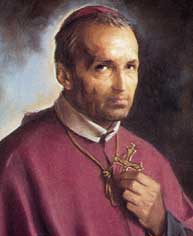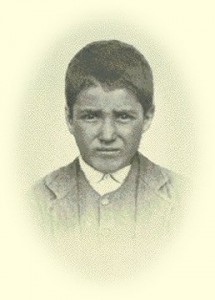Our Lady of Czestochowa
Feast day: August 26
Our Lady of Czestochowa, or the Black Madonna of Poland, is a very famous painting of the Blessed Virgin holding the Child Jesus. Under this title, Mary is the Patron and Protector of Poland. Since the face of Mary is very dark, she is referred to as the Black Madonna. This darkening of the image comes from centuries of being hidden and the many years of soot and smoke from candles illuminating the icon. The picture follows the traditional form of an icon. Mary gestures toward Jesus, directing the attention away from her and pointing to Jesus as the source of salvation. The child Jesus extends his right hand in blessing to the viewer of the painting and holds a book of the gospels in his left hand. As in many icons Jesus looks like a small man, reminding us that Jesus, while still a child, is fully mature in his Divine nature.
The painting of the Madonna has a long history. Legend has it that it was painted by Saint Luke on a piece of a cedar tabletop built by Saint Joseph. Some even say it is part of the table used at the Last Supper. Saint Helen found this painting when she went to Jerusalem in search of the true cross. She gave the painting to her son, Constantine. When the city of Constantinople was invaded by the Saracens, the people prayed to Mary and the city was saved. This began the great devotion to the Blessed Virgin Mary attached to this painting.
The history of the painting is more accurately documented in 1382, when Prince Ladislaus was owner of the painting. In that year, when the Tartars were invading the Prince’s palace, an arrow hit the painting, lodging in the throat of Mary. Prince Ladislaus decided to take the icon to Opala, the town where he was born, in order to keep the picture safe. On the journey there, he stopped and spent the night at Czestochowa. The next day, as they began to continue the journey, the horses pulling the wagon with the painting of Our Lady refused to move. Prince Ladislaus took this as a sign that the painting was to remain in Czestochowa. The icon was placed in the care of the Order of the Hermits of Saint Paul at their monastery called the Mount of Light, or in Polish, Jasna Gora. The icon of the Black Madonna, Our Lady of Czestochowa, is there to this day.
The icon was again in danger and damaged in 1430 when the Hussites invaded the monastery. Twice the painting was struck with a sword, and before it could be hit the third time, the looter fell to the ground and died. Despite trying to repair the painting, the sword cuts and the arrow wound are still visible in the painting today.
In 1655 Swedes invaded Poland. The people prayed to Mary, and Poland was again saved from the invaders through the intercession of Mary. Our Lady of Czestochowa was thus crowned as the Queen of Poland, and this icon became the symbol of national unity.
There is even a modern legend from the time Russia invaded Poland in 1920. The Russian army was ready to attack when an image of Mary was seen in the clouds. At this vision, the troops withdrew and Poland was again saved. The Church honors Mary, the Mother of God, in various ways. Mary can intercede for us, as is evidenced by the many healings and miracles that have been attributed to prayers to Our Lady of Czestochowa over the years.
Connecting to Blest Are We® Parish and School
Grade 6, chapter 20




Comments are closed.